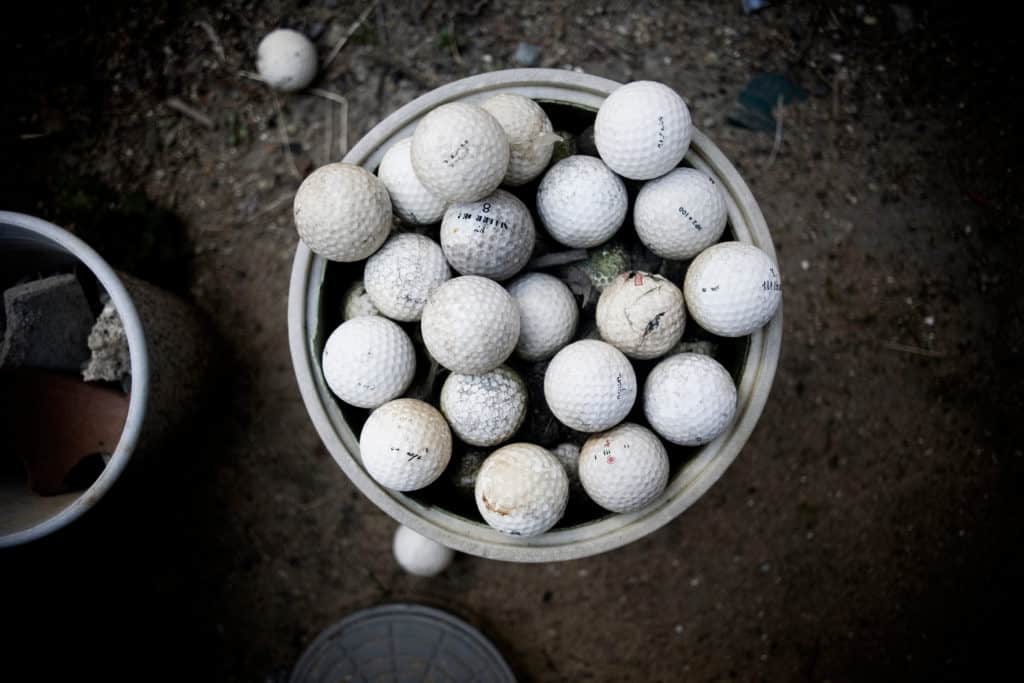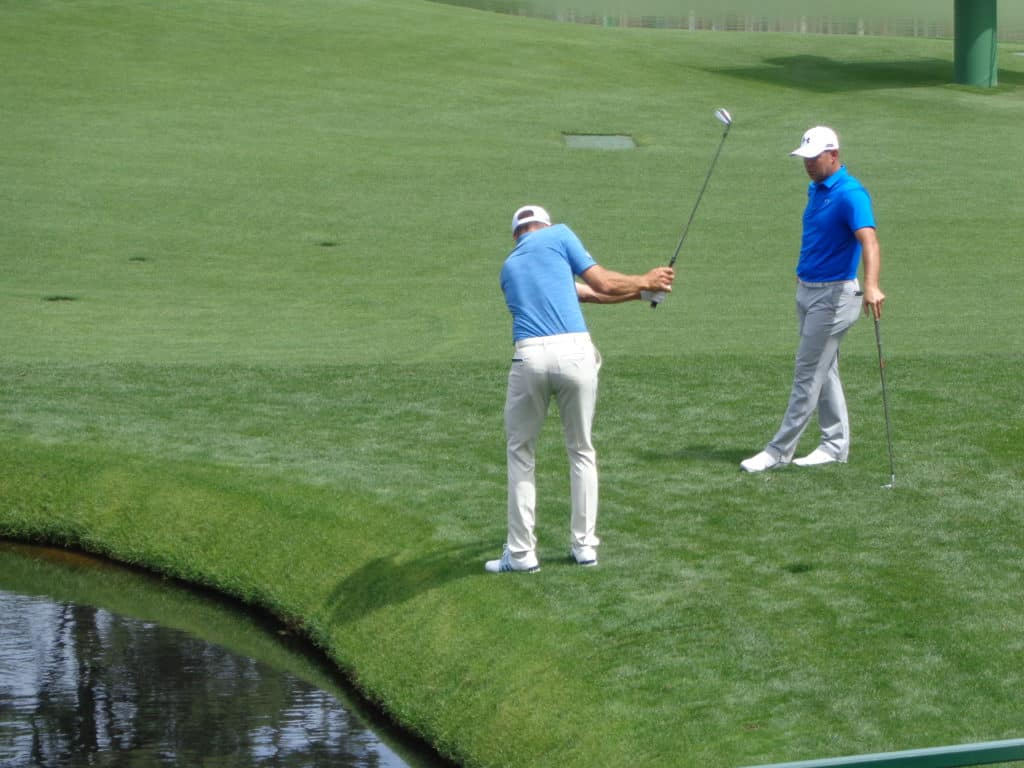The 4 basics of chipping are the ability to control the club face, control the swing direction, control the low point, and control your distance the ball travels.
When a golfer can chip at a high level the entire game seems easier. It takes stress off of the driver and approach shots.
When a golfer misses a green the mindset will shift from, “I have to hit this chip shot” to “I get to hit this chip shot and I can make it.”
Overall, having confidence in the technique, your touch around the greens and the right mindset will help you take advantage of the opportunities to chip and get you in a place where you can tap in for par or possibly even hole out for birdie.
Too many golfers approach the chip shot with fear of embarrassment. They fear the chunk shot or the bladed shot over the green.
Instead, make sure you follow the tips below to help you stop fearing these shots and instead see them as scoring opportunities.

What Are The Basics of Chipping?
Below, I will dive into these 4 basics a bit further and then provide 5 tips to help you chip better as early as your next round of golf.
The Basics of Chipping
- Control the club face
- Control the swing direction
- Control the low point
- Control the distance
The Basics of Chipping: Control The Club Face (1)
The best golfers have a quality grip. The golfer can either use their standard grip or change to their putting grip. Ensuring the club is centered and squared with whatever grip you decide on is important.
Being able to maintain the club face and keep it in the direction you want to start the ball is the first basic of chipping. The advantage of the putting grip is that it often places the hands a bit higher, which helps the golfer better utilize the bounce on the club.
The putting grip can lead to less chunked or bladed shots and enables the club to work through the ground and not drive into the leading edge. If the hands move too far forward, the end result may be a shot where the leading edge hits the ground before the ball leading to an ugly and often feared chunked shot that leaves the ball about 2 yards in front of your previous location.
Update: Struggling with chipping? Check out this post on an alternative method!
The Basics of Chipping: Control The Swing Direction (2)
Pretty simple concept here. The golfer, because it is such a short swing anyways, will take the club back and through. The golfer that tends to drag the club instead and push the clubhead to the outside has too much manipulation in this short of a swing to ever recover.
The golfer should work to keep it simple and imagine a putting stroke where the swing is more straight back or through or might have a slight roundness to it, but nothing extreme.
The Basics of Chipping: Controlling the Low Point (3)
This is an area where a golfer should truly focus because until you can control the low point, your short game will suffer greatly. Nothing is worse than having a variable low point and hitting the ball all over the course, from chunk shots to bladed shots.
This makes the game miserable and can lead to someone quitting the game. If this is you, make sure you check out the 5 tips below to help you overcome this and learn to control the low point.
The Basics of Chipping: Controlling the Distance (4)
The distance of a chip shot is impacted by the speed of the swing, the length of the swing, and the loft of the club.
A golfer has plenty of options from an 8 iron all the way up to the 60 degree wedge. Keeping a more simple motion similar to a putter, a golfer can use the speed or overall length to hit a different distance with the same club. Spending on the pin placement the golfer will utilize different options.
The golfer should practice a 7 o’clock, 8 o’clock, and 9 o’clock swing with each club at three different speeds. These speeds would be fast, medium and slow. This gives the golfer 9 different distances with each club.

The Basics of Chipping: 5 Tips
Tip 1: Get Your Sternum Forward
What this helps: Controlling the low point
Your ball placement should be slightly behind the center of your chest. This keeps your sternum ahead of the ball, which is where your club will bottom out. While a golfer should work on keeping the swing forward the club will have a low point.
If you are struggling with your low point, chances are you are manipulating the club face or your sternum is not in the right location. Keep it simple like a putting stroke and start by hitting the most basic bump and run chips with a 9 iron.
Tip 2: Use A Putting Like Motion
What this helps: Controlling the swing direction and the low point
If you think of putting, you often can get the ball started in the general direction and you probably never chunk a putt. This is because you are using a simple back and through motion where the club rocks back and through.
If you are struggling with your chipping, keep this simple motion in mind and test out the three different speeds to control your distance (fast, medium and slow) with three different potential lengths (7, 8 and 9 o’clock). This most basic chipping motion will give you plenty of options and you will be able to hit the majority of chip shots that you will face on a course.
Tip 3: Build Your Feel
What this helps with: Controlling the distance
The reality is that becoming a great chipper of the ball will take some work and practice. Start by using your chipping technique with 3-5 different clubs to build your overall distance control patterns.
Building the feel of how far shots will travel with the different options. Remember you can control the club loft selection, the length of the swing and the speed of the swing. Experiment with these different options and build your feel.
Head to your local practice green and hit plenty of shots adjusting the different variables. The next time you play, you will be able to rely on this feel and select the shot you need based on the circumstances you are facing.
Tip 4: Focus on the Task
What this helps with: Controlling the low point
Too many golfers stand over a shot with great fear and anxiety about the embarrassment they face from an ugly chip. You know the one where the turf flies further than the ball or you blade it over the green into the water hazard.
The best way to get rid of this “yip” like motion is to focus on the task. When you give yourself a swing length and the speed you want to move the club, your focus turns to the task at hand. You can remove the doubt in your mind and simply complete the task you are giving yourself.
Of course it will take repetitions and practice as confidence is a major part of this overall routine, but get lost in the task when practicing and during your actual rounds. This will help clear the mind and our minds are much better at completing a task when it has clarity.
Tip 5: Use the bounce
What this helps with: Controlling the low point
Another tip to help with the dreaded ugly chip shot is to use the bounce on the club. This means setting up with your hand only slightly ahead of the clubface at address. If your hands get too far forward you start to bring the leading edge into play too much.
If you watch the professional golfers you will see that sometimes they hit slightly behind the ball, but with the hands more closely inline with the club face, they are able to utilize the bounce on the bottom of the club to glide through the grass instead of digging into the ground which would happen if they had too much leading edge taking place.
You don’t have to add extra loft at the bottom, but make sure not to lead with your hands too much, which pushes the club head back and brings the leading edge into play.
Instead simply try to match up your address position when chipping. This is different from the full swing, but speed is nothing something we need to create for the 5-15 yard chip shot. It is much more about speed control, and club face control to get the ball started on the right line and travel the distance we want.

BONUS TIP: Create A Routine
What this helps with: Everything
Go through your routine when you are hitting a chip shot. Things to consider:
- Access your lie when you first get to the ball.
- Walk onto the green and determine the slope of the green. Is is breaking a certain direction, and is the green more uphill or downhill from where you are hitting from.
- Determine where the ideal spot to land the ball.
- Once back at your ball, with the ideal landing spot in mind, determine what combination of loft, speed of swing and length of swing will get that shot to land on the spot and run towards the hole at the right pace.
- Take several rehearsals focusing on the length of the swing and the speed of the swing.
- Step up with a target and task and mind and execute the length and speed of swing that you need.
This will help you get lost in the process and the task and help eliminate the dread yipped shot.
Basics of Chipping: Additional Thoughts
For years we have seen the likes of Phil MIckelson and other greats chipping with their hands way forward utilize a 60 degree club frequently. This is great if you have some amazing touch and can deal with the nerves.
However, if you are playing golf only several times a week and want the most consistent chipping motion, I highly recommend using this approach above. Setting up to maximize the bounce with a focus on the length of swing and speed of swing, you will build your routine and your feel and have confidence over chip shots.
Some golfers can do what Phil does, but many amateurs will struggle with the confidence and consistency of the clean contact.
How To Get Better at Chipping: 7 Key
Here are some key to get better at chipping:
- Use a simple technique (putting like motion)
- Have a variety of shots you can utilize (loft, length and speed are three variables to create a variety of shots)
- Go through a process and get lost in the task
- Practice frequently
- Keep your setup simple with your sternum just forward of the ball
- Compete with yourself on the practice green or with others.
- Test your skill by assessing how many times out of 20 you can get up and down from different spots around the practice green. Do this assessment at least once a week to measure your progress.

Frequently Asked Questions
What is the difference between chipping and pitching?
A chip shot takes place right off the green and up to 15 yards. The pitch shot is from 15 to 40 yards and is the longer shot. Overall the chip shot utilizes a more simple motion that is similar to a putting motion. A pitch shot utilizes some slight wrist hinge and generally takes a longer swing motion.
I am an amateur golfer on a journey to get better, enjoy the game as often as possible and share my passion and knowledge with others. I have coached high school golfers at a high level and have a great passion for the game and want to give back. I enjoy learning about the golf swing and am currently studying to be a certified professional golf instructor. Join me in our journey to get better everyday.

